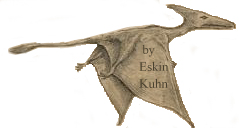In my nonfiction cryptozoology book Live Pterosaurs in America (third edition), the title of the seventh chapter is “The Truth of Tall Tails.” Why do so many “pterodactyl” sighting reports involve apparent Rhamphorhynchoid tails (long, often seen with a “diamond” or “spade” or similar shape at the tail end)? Most modern pterosaurs, apparently, are long tailed. From the book:
[In 2006] my friend, fellow ropen seeker Garth Guessman, told me of three eyewitnesses of Pteranodon-like animals near a mission on New Britain Island, east of Umboi. They had ten daylight sightings, 1989-1991, of tail-less or short-tailed featherless creatures that glided over a valley, deep in the island interior. Guessman gave me detailed reports of the descriptions given by these three Americans. The combined descriptions convinced me that those three had reported actual events; it was no hoax-collaboration. But most sightings are of long-tailed pterosaurs.
Sightings in the United States seem to indicate at least a 4-1 ratio favoring long-tailed pterosaurs over short-tailed or no-tailed ones. . . .
What about these short-tailed or tail-less pterosaurs? The book gives examples.
Southern California desert, 1991 sighting:
“I have been haunted for close to twenty years by what I saw in the desert. I have never told anyone due to the fact that I was afraid I would be thought nuts. . . . I can’t tell you what a relief it is to know I am not alone. . . .
“We were sitting in the late afternoon shade of a ridge, on lawn chairs, enjoying the solitude and peace and quiet of the desert when it passed over. I caught the sight of it with the corner of my eye . . . It was soaring along the side of a plateau not far from us. We knew what it looked like. In fact, I remember saying ‘. . . that looks just like a Taradactyl!’
“My friend looked in the binoculars and said it looked like one but it had to be a kite or something because they were extinct. . . . I grabbed the binoculars and looked for myself. What I saw was large and very much alive. Its hue was close to the hue of the desert sand but more the color of rust. Its skin, I say skin because there were no feathers, . . . looked like dull leather sort of dusty looking. . . . The back of the head was pointed.”
Anza-Borrego State Park, California
Tales of Pterosaurs With Long Tails
I was surprised, in July of 2008, by a phone call from a man who told me that I was wasting my time by going to Papua New Guinea looking for pterosaurs. I considered bringing our short conversation to a close, thinking he was ridiculing the investigations, when he got to the point: One year earlier, he had witnessed for himself a large pterosaur flying over a road in Southern California.
Could he have been mistaken about the 15-to-16-foot-long tail of the flying creature? I’ve thought about that, over the years, but have found it difficult to image how it could have been greatly exaggerated, since the total length of the creature he estimated at thirty feet, and it had flown low, right over a road that I have since measured: At this location, Campus Drive is thirty feet wide.
Campus Drive, near where an apparent ropen flew in 2007
Could the man have been playing a hoax? I investigated him briefly but long enough: He works in a professional field (doctor, lawyer, firefighter, or police officer—I won’t go into detail) that practically eliminates a hoax explanation, for his career could be damaged by that kind of joke, should I publish his name. Besides, he gave me no cause to suspect any hoax.

Texas Pterosaur (“pterodactyl” sightings in the Lone-Star state)
. . . what some particular eyewitnesses have observed in Texas are not fossils, and the correct general name for the flying creature is “pterosaur,” not “pterodactyl,” but why could they not live in Texas?





One Reply to “The Truth of Tall Tails”
Comments are closed.